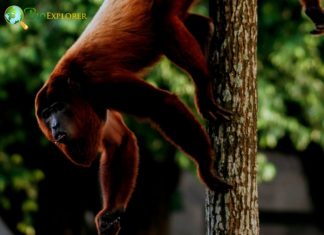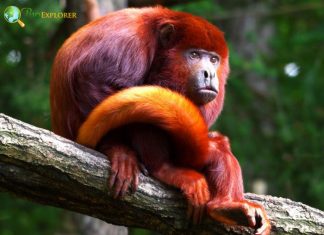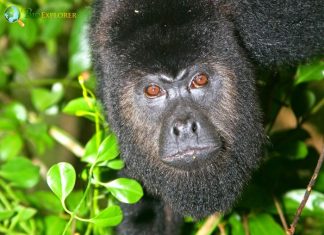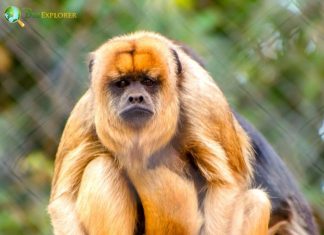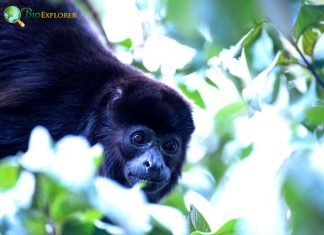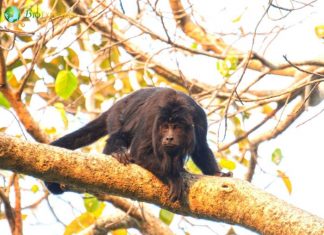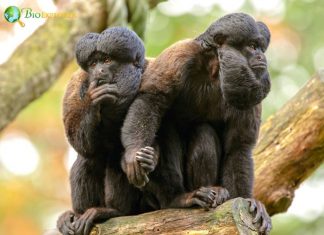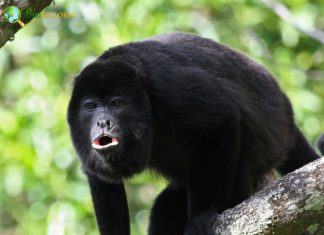Red-handed Howler
Species Name: Alouatta belzebul
The red-handed howler monkey (Alouatta belzebul) is an endangered species of howler monkey, a New World species. Red-handed howler monkeys are diurnal, although they spend most of the day (up to 80%) sleeping on tree branches with members of their squad.
Ursine Howler
Species Name: Alouatta arctoidea
The Ursine howler (Alouatta arctoidea) is a species of howler monkey endemic to Venezuela and possibly Colombia. These howlers are famous for their "morning chorus".
Spix’s Red-handed Howler
Species Name: Alouatta discolor
Spix's Red-Handed Howler (Alouatta discolor) is a species of howler monkey endemic to the southeastern Amazon in Brazil. Spix's Red-headed Howler is currently on the International Union for Conservation of Nature's Endangered Species List based on a population decline of more than 30% over the last 3 generations, mainly due to habitat loss.
Maranhão Red-Handed Howler
Species Name: Alouatta ululata
The Maranhão red-handed howler (Alouatta ululata) is native to forests (e.g., Babaçu forests) in the northeastern Brazilian states of Piauí, Maranhão, and Ceará. Red-handed howler monkeys are among the least studied species of all howler monkeys.
Guyanan Red Howler Monkey
Species Name: Alouatta macconnelli
The Guyanan red howler monkey (Alouatta macconnelli) also known as Guianan Red Howler, is a New World monkey native to Guyana, Suriname, Trinidad, Venezuela, and Brazil. Each troop has a hierarchy consisting of a single dominant alpha male, sometimes with 1 or 2 subadult males. The rests are females and their young.
Bolivian Red Howler
Species Name: Alouatta sara
The Bolivian red howler monkey is a New-World monkey species native to neotropical South America. The Bolivian red howlers live in groups of 1 to 3 males and 2 to 7 females. Males in bachelor groups try to dominate the female group by wrestling the lead male.
Red Howler Monkey
Species Name: Alouatta seniculus
The Colombian red howler or Venezuelan red howler is a South American species of howler monkey, a New World species of monkey found in the western Amazon basin. Colombian red howler monkeys live in relatively large social groups composed of around 10 individuals, with just one or possibly two of the individuals being male.
Yucatan Black Howler
Species Name: Alouatta pigra
The Yucatan black howler, also called the Guatemalan black howler or Central American black howler, is a New-World monkey native to Central America. The Yucatan black howler monkey is the largest species of howler monkey and among the largest monkeys in the New-World.
Brown Howler Monkey
Species Name: Alouatta guariba
The brown howler monkey, also called the brown howler monkey, is a species of New World monkey that lives in the forests of southeastern Brazil and northeastern Argentina. Despite the common name "brown howler", its color is remarkably variable, with some individuals mainly appearing black or reddish-orange.
Mantled Howler Monkey
Species Name: Alouatta palliata
The Mantled howler monkey (Alouatta palliata) is a species of howler monkey, a New World monkey native to South and Central America. The species gets its name "mantled" from the long, protective hairs on its sides.
Black Howler monkey
Species Name: Alouatta caraya
Alouatta caraya is found in the tropical rain forests of central South America, extending through eastern Bolivia, Paraguay, southern Brazil, and northern Argentina. Alouatta Caraya monkeys are sexually dimorphic, with males weighing an average of 6.7 kg and females an average of 4.4 kg.
Black Bearded Saki
Species Name: Chiropotes satanas
The black-bearded saki is a species of bearded saki, a species of New World monkey, one of the five remaining monkeys of its kind. Another striking feature is its signature beards. This species prefers primary rainforest, where lush tree canopies provide a relatively safe area out of sight and out of reach of several predators.
Amazon Black Howler
Species Name: Alouatta nigerrima
Amazon Black Howler is a New World tropical arboreal characterized by densely furry, prehensile tails, all-black faces, a stocky build, relatively large size, and loud howls. According to researchers, its howl sounds like a strong wind blowing through a tunnel can be heard more than two miles away.







